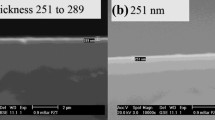Abstract
We carried out the thin film deposition of iron silicide by pulsed laser ablation (PLA) on a sapphire substrate, which was placed on a high-speed rotating titanium disk. The deposited thin film exhibited a continuous composition gradient. We investigated how the continuous composition gradient was attained, because the strength of the gravity field in our experiment was far below that in the experiment on bulk crystalline compounds. In the present study, we obtain the spatial distribution of several species in the PLA plume of FeSi2 by using an intensified charge-coupled device (ICCD) camera.
We obtained the distribution of each species through high-speed imaging using narrow bandpass filters, whose wavelengths corresponded to the emission wavelengths of Fe2+, Fe+, Si2+, Si+, and neutral Fe. From the observed images, we could identify the particle species as well as determine the average velocity and the relative number density of each species.
The Fe2+ ions, Fe+ ions, and Fe atoms had quite different average velocities as a result of which they formed separate groups while moving toward the substrate. Species with the same valence value moves with the same velocity. We believe that the compositional gradient of FeSi2 attained under an appropriate gravity field may be explained by the movement of both the components driven by the acceleration field and the effect of selective etching.
Similar content being viewed by others
References
T. Yoshitake, T. Nishiyama, K. Nagayama, Jpn. J. Appl. Phys. Part 2: Lett. 40(6A), L573–L575 (2001)
T. Yoshitake, T. Nishiyama, K. Nagayama, Diam. Relat. Mater. 9(3), 689–692 (2000)
T. Mashimo, Phys. Rev. A 38, 4149 (1988)
T. Mashimo, Acta Astronaut. 48, 145 (2001)
T. Mashimo, S. Okazaki, S. Shibasaki, Rev. Sci. Instrum. 68(11), 4225–4231 (1997)
T. Mashimo, X. Huang, T. Osakabe, M. Ono, M. Nishihara, H. Ihara, M. Sueyoshi, K. Shibasaki, S. Shibasaki, N. Mori, Rev. Sci. Instrum. 74(1), 160–163 (2003)
D.L. Beke, Z. Erdélyi, Phys. Rev. B 73, 035426 (2006)
Z. Erdélyi, D.L. Beke, A. Taranovskyy, Appl. Phys. Lett. 92, 133110 (2008)
T. Nishiyama, S. Iba, Y. Kurogi, K. Nagayama, in Proc. 56th Int. Astronautical Congress, CD-ROM IAC-05-A2.1.01 (2005)
T. Nishiyama, S. Morinaga, K. Nagayama, Rev. Sci. Instrum. 80, 033904 (2009)
A.R. Striganov, N.S. Sventitskii, Tables of Spectral Lines of Neutral and Ionized Atoms (IFI/Plenum, New York, 1968)
Author information
Authors and Affiliations
Corresponding author
Rights and permissions
About this article
Cite this article
Kajiwara, T., Nishiyama, T., Morinaga, S. et al. Optical emission spectroscopy of thin film fabrication by pulsed laser ablation under high-gravity. Appl. Phys. A 101, 739–742 (2010). https://doi.org/10.1007/s00339-010-5932-5
Received:
Accepted:
Published:
Issue Date:
DOI: https://doi.org/10.1007/s00339-010-5932-5




